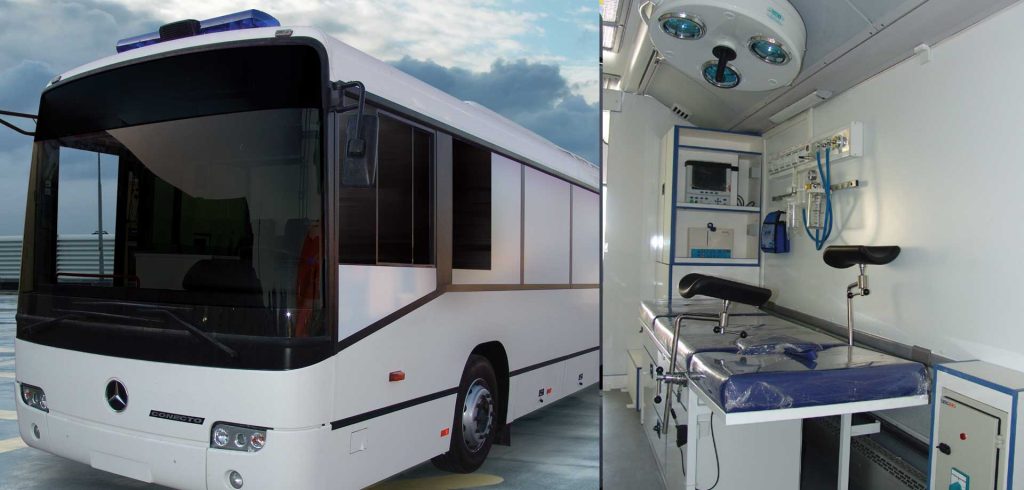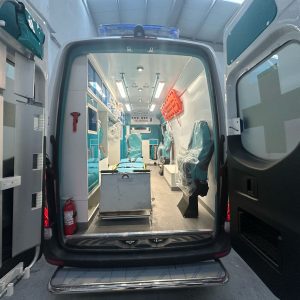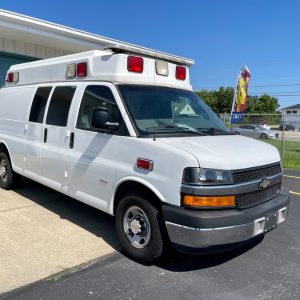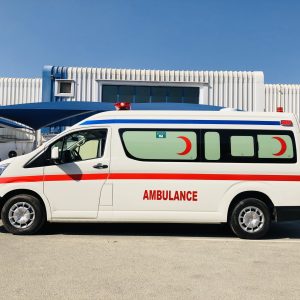1. Introduction
Mobile Gynecology Vehicles; The concept of medicine is to provide medical care where it is necessary, at the necessary time, and can improve recovery rate and save lives. However, the infrastructure of medical institutions is developed only in populated areas, but there are still disparities between industrial areas and urban areas. In particular, the lowest capital construction ratio and economic operating standard ratio for gynecology. The average distance to medical clinics and hospitals is different by region. Risk factors for health and fertility, development risk, childbirth risk, and risk factors are difficult. The obstacles faced by people and the obstacles to medical services. The construction of the obstetrical and gynecological clinic will make it possible to provide medical care, eliminate obstacles to the use of medical services, and prioritize medical services despite diverse obstacles. This study suggests the construction of a mobile gynecological vehicle in order to overcome the obstacles facing the construction of medical services.
There are vehicles that travel to provide various medical services, such as dental vehicles, breast diagnostics vehicles, prenatal checkup vehicles, and immunization vehicles that are currently being operated in Korea. However, vehicles that provide general gynecological services are not available. Therefore, it is necessary to construct a vehicle that can diagnose all areas that can be detected and diagnosed in general clinics such as breast ultrasound, breast mammography, breast specimens, vaginal ultrasound, cervical uterine cytology, endometrial, breast, bartholin, etc. inbuilt gynecology. The construction of a mobile gynecology vehicle requires accurate design and medical equipment to provide medical care similar to that provided by a general hospital. Although there is a construction vehicle, medical care can be provided only if there is no medical care provision. Customers may refrain from using the service if appropriate medical care cannot be provided. To propose the structure and requirements of medical devices that provide the proposed service, we conducted industry and related industry consultation. This study aims to suggest the structure and specifications of medical equipment fitted to the proposed mobile gynecological vehicles.
2. The Need for Mobile Gynecology Vehicles
Mobile gynecology is one of the most important aspects of preventive medicine. Mobile gynecology vehicles can reach women living in areas with difficult access or underdeveloped in terms of health services. We carried out this investigation with the aim of employing a mobile gynecology vehicle that would make it possible to provide services to female patients who are unable to go to hospitals for biological and geographical reasons at international medical and healthcare standards. In this context, the examination and sampling equipment of the mobile gynecology vehicle should be such as not to be inferior to the state hospital standards. The aim of this investigation was to establish the institutional setting of the 3-4 mobile gynecology vehicles intended to enter into the 81 provinces in Turkey and to determine and deliver specific policies.
The research employed the count measure estimation model to examine the effect of demand for service utilization on gynecological diagnosis in these vehicles based on data gathered from a cross-section of 150,000 people for mobile gynecology vehicles belonging to 13 cities in Turkey between 2002-2006. The data gathered from the questionnaires that were completed on the mobile gynecology vehicle especially allocated for the research. According to the findings obtained from the research, the data gathered from the theoretical models applied for the detection, diagnosis, and utilization rates of users is consistent with the empirical findings. The main result of the study is that the main reasons for the patients to go to the mobile gynecology vehicle are related to health policy. The results suggest that gynecology services should be included in periodic check-ups focusing on reservations for the patients going to the mobile service. In the services provided by the mobile gynecology vehicle, the sociopolitical and socioeconomic values of patient quality may be affected by regional macro factors and the quality of the service provided influences the satisfaction and qualification levels of the patient. This leads to changes in patient demand.
2.1. Challenges in Accessing Gynecological Care
As the infrastructure for medical examinations in areas becomes established and the national health system expands, access to basic health care is now widespread. In contrast, advanced health care is limited in rural areas, with mobile medical services increasing, with trends including mobile cancer screening buses and mobile ophthalmology vehicles. However, in the field of mobile medical services, mobile gynecology vehicles are almost nonexistent in terms of equipment and vehicle types despite a need. In the field of gynecology, it is not uncommon for women in rural areas to be unable to visit the hospital without any significant symptoms, resulting in a slight delay in seeking medical treatment, causing risk of treatment delay for diseases such as gynecological cancer, which need to be diagnosed early.
There are various barriers and obstacles to accessing gynecological care in rural areas. There are barriers and obstacles such as a strong sense of shame, lack of privacy and confidentiality, lack of information, refusal of care for sexual or immoral reasons, and fear of embarrassment and the physical examination itself. Furthermore, the underestimation of the necessity for gynecological care and the period of time from the presence of a symptom to the diagnosis and care of gynecological diseases, which are often perceived as something that will not affect “immediate” health. The patent evaluation of gynecological diseases is widespread. The term “patent bias” suggests that diseases are invisible to others and need to be recognized to influence the decisions of conscious individuals to receive medical care. In contrast, early detection is less likely to occur because gynecological diseases develop without any symptoms, and the period after symptoms appear to lead to decisions about care being pushed back. In contrast, individuals may view bipedal imaginative individuals as potential services they can avoid.
3. Design Considerations for Mobile Gynecology Vehicles
This chapter describes the status quo and development of mobile gynecology (MG) at home and abroad, and explores the configurations, allocation principles, and optimization directions of medical equipment and layouts of mobile medical vehicles. Mobile gynecology can provide convenient continuous medical services for the residents. Well-known cars, suitable drugs, professional pictures, and a complete team are four aspects that should be considered for MG. The model, layout principle, selection, and design of medical equipment and drugs for mobile gynecology vehicles are also included in this chapter.
When designing cars or container vehicles for clinical care of different levels and in different fields, not only medical professionals should be considered, but also ancillary professionals. The design of such cars or container vehicles requires both a professional medical design team and sufficient medical design experience. Hospitals are inseparable from medical care, transportation, education and teaching. Hospitals play an important role in clinical care, which is difficult to replace by patient referrals. Educational medical practice of teaching hospitals is an extension of clinical care and education on medical education function, and improves both the hospital and teaching hospital functions. The patient treatment (care) with improved teaching hospitals can provide a good practical education base for medical practice and teaching of medical students. With the progress of society, hospitals should be better integrated into society, transformed to design of teaching and medical facilities, and extended to the community. Similarly, with the development of urbanization, increases in aging, chronic diseases and population mobility, hospitals will be relocated to the community, and the current role and function of community medical services cannot be replaced. This role and function will become stronger and the installations will undergo further development. Such a hospital will ultimately be able to make multiple innovative and flexible changes directly in the design of community facilities. Residence.
A general vehicle or container used as a temporary car is called a mobile unit MUA (Medical Care Unit MUA). After a mobile higher-level schedule is integrated according to various configurations, it can be divided into different configurations, and some hospitals can also increase remote locations to meet the needs of the locals. After configuration formed by the design of high-level scheduling service MOA. This concept is distinguished in the Chinese vocabulary. MOA is limited in some conditions and we are currently resolving problems for MUA. Medical Care Mobile Unit can also be categorized as either a light vehicle or a container vehicle. Based on the design characteristics, this chapter focuses on both.
3.1. Space and Layout Optimization
Mobile gynecology vehicles are cars, buses, or mobile medical vehicles that can travel. Considering these characteristics, the size and space are limited; therefore, it is essential to optimize and anticipate the space for medical instruments. This research aims to provide a solution to the critical problem, which was found during a survey of mobile gynecology vehicles in Korea. The problem was that there was no standard or proposal for the size or on the space organization of a mobile gynecology vehicle. To prepare an initial design, the API was briefly analyzed and evaluated for most medical devices and equipment that are medically essential and can be relocated. Moreover, for effective usage of space, a table style and installation space were provided. It is urgent to reduce the size and weight of the medical equipment that is used in the mobile gynecological vehicle, in order to develop a long distance type.
According to the American College of Gynecologists (ACOG) in 2009, since the characteristics of American female patients have changed, it is important to aim for a new approach, to plan and comprehend current and new technologies. They decided that these changing requests should be satisfied by a Monogram-detail/Mobile-GYN. They understood that the Physical Monogram facility was detrimental, but also that to be accompanied by an appropriate staff both in service sites and administration, it was essential to meet women’s daily needs. In the same year, Korea’s Gynecologic Society discovered and discussed the existence of pre-cervical cancer screening authorities in rural areas because of the inconvenient service, the aging population and regional distribution. In Korea, the number of gynecologists has decreased because the working hours are something that causes them to be compelled to leave their jobs. Moreover, the main cause of leaving is the family’s burden, wage difference, medical lawsuit, and so on. At present, it is regarded as Korea’s society’s crisis. Another reason why the world’s developing countries were suffering from gynecological problems was because most of them did not have a proper environment to support the possibility of no-gynecologists.
4. Essential Medical Equipment for Mobile Gynecology Vehicles
Mobile gynecologic vehicle policy is the main driving force for the development of mobile gynecologic vehicles. The vehicle has the function of a mobile inspection clinic that can reach people and groups who have difficulty seeking medical attention. A mobile gynecologic vehicle is a soft mobile diagnostic facility integrating medical services such as health care, inspection treatment, and first aid. It is composed of the automobile part and the clinical medical part. The vehicle part provides safe, convenient, and rapid travel conditions, and the clinical medical part can meet the demand through various mobile medical equipments, protective devices, and telemedicine systems. This section will explain in detail the requirements for vehicle interior spaces, specifications, and configurations of individual medical equipments.
By summarizing the inspection process, combining the experience of clinical gynecologic examinations, and referring to the national standard “JS T2053, Minibuses, Midibuses, and Small Buses,” a series of gynecologic examinations required for a gynecologic mobile examination vehicle have been established, that is, basic functions, ordinary functions, and extended functions. All mobile gynecologic vehicles must first meet the basic functional requirements, including specific requirements for vehicle interior spaces, medical equipment systems, and vehicles, and a variety of indicators that are guaranteed for vehicle performance, safety, and the environment. According to basic diagnostic requirements and related regulations, real-time simple detection and assisted technology testing can improve the basic diagnostic functions and performances of mobile gynecologic vehicles, including urine tests and B-mode ultrasound auxiliary diagnosis, etc. At the same time, in order to adapt to the follow-up diagnostic requirements, some requirements have been formulated for future development. The vehicle body shall have an independent space for equipment storage and basic functions. The limited width/height of the vehicle door opening, the height of the vehicle and the ground clearance, the lighting conditions in the examination area, and other indicators related to the clinical use of facilities shall comply with the requirements for room environments and ventilation laid down under the protection regulations for diagnostic radiology. Health and safety standards for medical exposure must be considered. The microenvironment for the patient and the nurse should also meet the basic requirements for air quality in the operating room. The vehicle must be equipped with a waste collection facility for urine or other specimens, and a temporary quarantine for infectious waste shall be established on the vehicle.
Tables are provided to show the vehicle interior spaces of three types of mobile gynecologic vehicles including basic functions, ordinary functions, and extended functions; vehicle specifications for the mobile gynecologic vehicle; and medical equipment configurations for three levels of mobile gynecologic vehicles. The functional areas of gynecologic examination, medical treatment, and on-board facilities are indicated. The establishment of an entry depot is suggested to reduce unnecessary complex equipment configurations. Based on the regional and local climates, different types of mobile gynecologic vehicles that are suitable for varying transport on regional road conditions and special roads are presented. We also address the vehicle energy structure interface, and several types of mobile gynecologic vehicles are suggested. The function and energy improvement of electrical vehicles (EVs) and fuel cell vehicles (FCVs) are emphasized. Future work on four dimensions is discussed regarding the driving distance and cruising range, network system technologies, development policies and regulations, and environmental and air control of mobile clinic vehicles.
4.1. Ultrasound Machines
Mobile gynecology vehicles must be fitted with state-of-the-art technological medical equipment and systems. These include X-ray machines, mobile ultrasound machines, and colposcopes. Depending on the different uses of the mobile gynecology vehicle, it can also be fitted with various advanced medical facilities and equipment such as hysteroscopes, cryogenic equipment, electrocoagulation equipment, and anesthesia instruments. The huge market demand and demand generated by the significant social economic benefits have driven the development of various types of large, medium, and small mobile gynecology vehicles. However, at the time of writing, relevant international standards and specifications for medical devices used in mobile gynecology vehicles have not yet been established.
This paper describes and sums up experience in the selection of medical equipment used in gynecology vehicles. This includes X-ray machines, mobile ultrasound machines, and colposcopes. These were tailored to the size and usage requirements of mobile gynecology vehicles as a baseline to guide the future activities to standardize use in the development of the relevant medical device requirements and objectively select superior medical equipment for use in mobile gynecology vehicles. The report is organized as follows: Section 4 describes the characteristics and main types of relevant ultrasound machines and specifies their functional requirements. In Section 5, reverse engineering research methods have been conducted on the service gynecological ultrasound machine. The processing characteristics mainly cover software programming and the final design and analysis of an onboard digital ultrasound diagnostic machine. Our method and the conclusions of the resultant study are presented in Section 6.
5. Technical Specifications and Requirements
The paramount importance of mobile gynecology services in promoting the well-being of women in society is widely accepted. The importance of medical examination in the early diagnosis of gynecological diseases is similarly recognized. The Ministry of Health and Welfare and local health centers provide free annual gynecological examinations, but the current hospital-stationing environment barely meets the needs of women. Nationally, only 2% coverage is reached. Women in remote or rural areas still need transportation to enable them to access remote medical service centers. However, the physical, verbal, financial, and psychological pressures women face are substantial. To achieve the purpose of early tumor detection, a more comprehensive policy is necessary.
The objective of mobile gynecology clinic activities is to provide free screening services for cervical cancer and breast cancer for women in remote areas, in addition to pregnancy check-up services. In addition to offering medical knowledge counseling and public health-related promotional activities, we propose the innovative concept of our mobile gynecological vehicle. The gynecological vehicle is built into a trailer and contains a mobile examination room, a counseling room, a public health display room, and a kitchen. The vehicle can provide remote regions with various Very Important Person (VIP)-level services. This examination room uses the space for three purposes. First, before examination, women can discuss their retrieval details in the counseling room. Then, when performing the examination, the medical staff can call the woman from outside and invite her to enter this room. Finally, select a smaller space within the room to perform the examination using screening equipment customized for the vehicle.
5.1. Power Supply and Backup Systems
The power system and backup energy supply play a crucial role in mobile gynecological vehicles. Many medical devices target general hospitals and rely on stable power supply voltage, while most gynecologists and the vehicles of MGVs are utilizing medical devices to handle their daily gynecological work. MGVs with support for more standard medical practices are in need. Emergency backup power system should be prepared on gynecological car devices, which ensures the stability of the treatment process when the fixed power supply system in the hospital has problems. Vehicle power grid, power supply voltage, and frequency microscope evaluation are the basic evaluation and analysis entry points of the car medical devices and power supply and backup systems that need to be conducted. In addition, adjustable voltage and stable frequency properties are important indicators of on-board power generation devices such as generators. Researchers conducted a vehicle start-up scheme to understand how to conduct an emergency start of the vehicle when the main power system has problems. This study integrated the mobile medical device system configuration to verify that the display device screen settings systematically to conduct an experimental study. The power supply system and backup energy supply play a crucial role in mobile gynecological vehicles (MGVs). Many medical devices target general hospitals and rely on stable power supply voltage, while most gynecologists and the vehicles of MGVs are utilizing medical devices to handle their daily gynecological work. MGVs with support for more standard medical practices are in need. Emergency backup power system should be prepared on gynecological car devices, which ensures the stability of the treatment process when the fixed power supply system in the hospital has problems. Vehicle power grid, power supply voltage, and frequency microscope evaluation are the basic evaluation and analysis entry points of the car medical devices and power supply and backup systems that need to be conducted. In addition, adjustable voltage and stable frequency properties are important indicators of on-board power generation devices such as generators. Researchers conducted a vehicle start-up scheme to understand how to conduct an emergency start of the vehicle when the main power system has problems. This study further analyzes the power-based medical device usage algorithm, the battery life, the power system operation status, the communication power consumption, and the power supply priority of the vehicle when the vehicle has a backup power emergency, and the vehicle is driven when the power supply is low.













